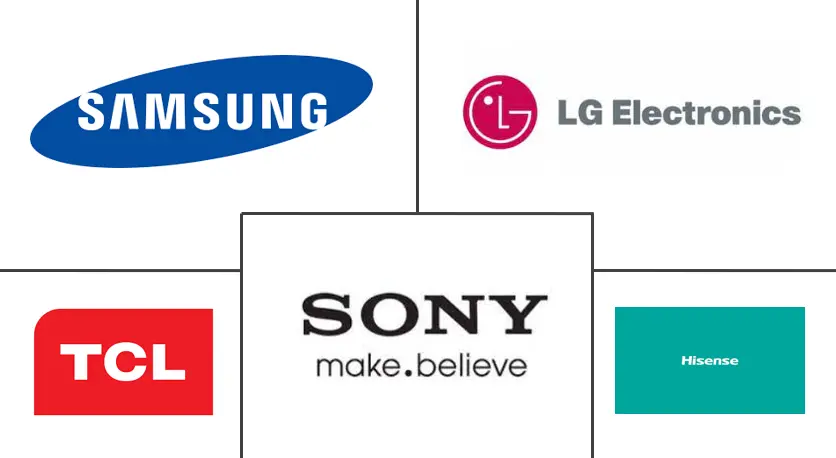Connected TV Market Size and Share
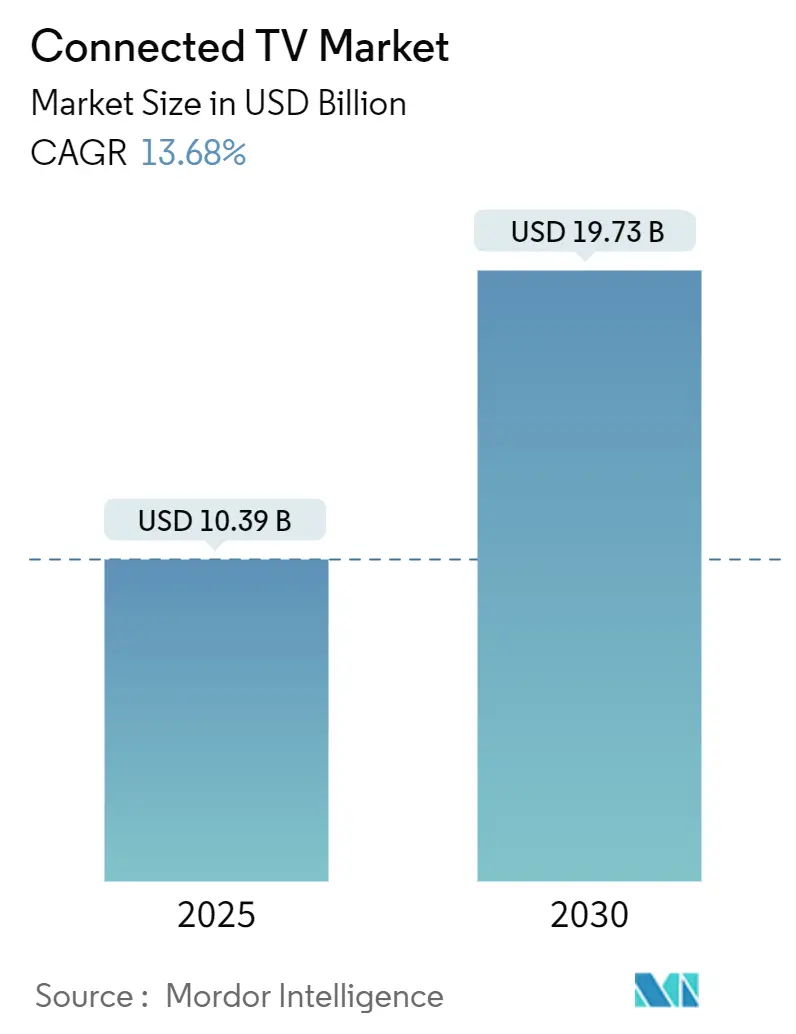
Connected TV Market Analysis by Mordor Intelligence
The Connected TV market is valued at USD 10.39 billion in 2025 and is projected to reach USD 19.73 billion by 2030, expanding at a 13.68% CAGR. Growth stems from households replacing single-purpose screens with integrated home hubs that merge video, commerce and cloud gaming. Free ad-supported streaming (FAST) broadens reach, while unified ad-measurement tools give brands confidence to transfer budgets from linear television.[1]Liam Mackatiessy, Tana Udalova, "Making CTV accessible to everyone," about.ads.microsoft.comHardware makers respond with power-efficient mini-LED backlights, on-device generative AI for upscaling and larger screen formats that meet user demand for cinema-like immersion. Telecom operators accelerate first-time adoption in emerging markets by bundling subsidised smart TVs with fibre subscriptions, anchoring users inside their service ecosystems and lifting average revenue per user.
Key Report Takeaways
- By device, Smart TVs led with 72% revenue share in 2024; gaming consoles used for streaming are projected to grow at a 15.6% CAGR through 2030.
- By operating system, Android/Google TV held 38% of the Connected TV market share in 2024, while Roku OS is set to expand at a 14.1% CAGR to 2030.
- By resolution, 4K UHD accounted for 66% share of the Connected TV market size in 2024; 8K displays are forecast to grow at a 15.5% CAGR to 2030.
- By screen size, 46 – 55-inch models captured 42% share in 2024, and sets 66 inches and above will rise at a 16.3% CAGR to 2030.
- By panel technology, LED/Mini-LED dominated with 78% share in 2024; OLED panels are on track for a 17.1% CAGR through 2030.
- By end-use, residential viewing commanded 83% of 2024 revenue, while hospitality applications are progressing at a 15.8% CAGR to 2030.
- By distribution channel, offline retail retained 62% share in 2024; online channels will move ahead at a 16.9% CAGR between 2025 and 2030.
- By region, Asia Pacific held 37% of global revenue in 2024, and the Middle East & Africa region will register the fastest 17.1% CAGR to 2030.
Global Connected TV Market Trends and Insights
Drivers Impact Analysis
| Driver | (~) % Impact on CAGR Forecast | Geographic Relevance | Impact Timeline |
|---|---|---|---|
| Proliferation of Ad-Supported FAST Channels Elevating ARPU in North America | +10.9% | North America, with spillover to Europe | Medium term (2-4 years) |
| Subsidised Operator-Bundled Smart TVs Accelerating First-Time Adoption in India & Indonesia | +8.2% | Asia Pacific (India, Indonesia) | Short term (≤ 2 years) |
| On-Device GenAI Upscaling Spurs 4K Upgrade Cycle in China & South Korea | +6.8% | Asia Pacific (China, South Korea) | Medium term (2-4 years) |
| Household Fibre Roll-outs Above 100 Mbps Boosting UHD Streaming in Nordics | +5.5% | Europe (Nordic countries) | Short term (≤ 2 years) |
| Advertising Measurement Standardisation (OpenAP, CFlight) Driving Brand Budgets to CTV in US | +9.6% | North America (US) | Medium term (2-4 years) |
| Cloud-Rendered Gaming Partnerships (NVIDIA GeForce NOW, Xbox Cloud) Creating New Use-Cases | +4.1% | Global, with emphasis on North America and Europe | Long term (≥ 4 years) |
| Source: Mordor Intelligence | |||
Proliferation of Ad-Supported FAST Channels Elevating ARPU in North America
Free ad-supported channels are reshaping revenue models as subscription fatigue lifts the appeal of cost-free viewing. Sign-ups for ad tiers formed 25% of total streaming additions in early 2023, and studios see triple-digit advertiser demand growth. Advanced targeting raises inventory value, letting Connected TV platforms command premiums over broadcast spots. Brands benefit from transparent reach metrics and flexible frequency controls that encourage reallocation of linear budgets. The dynamic widens platform margins and funds exclusive content that differentiates the Connected TV market from pay-TV.
Subsidised Operator-Bundled Smart TVs Accelerating First-Time Adoption in India and Indonesia
Telecom operators pair fibre plans with discounted smart TVs, lowering entry barriers for households that skip incremental upgrades and jump straight to connected screens. In Indonesia, the model is linked to a 5.1% rise in advertising spend for 2025, underscoring its halo effect on local media ecosystems.[2]Dentsu Indonesia, " Dentsu Ad Spend Report 2025," dentsu.comBundling drives broadband sign-ups, locks customers into longer contracts and opens cross-selling pathways for video-on-demand and cloud gaming. The approach compresses hardware pay-back periods through recurring service revenue, reinforcing the Connected TV market as a strategic extension of telecom portfolios.
On-Device GenAI Upscaling Spurs 4K Upgrade Cycle in China and South Korea
Third-generation AI chipsets elevate HD streams to near-4K clarity, motivating owners of legacy panels to upgrade. Samsung’s 2025 sets deliver 4,000-nit brightness and real-time language translation to broaden foreign-title access.[3]Flatpanelshd, "Samsung 2025 TV Line-up," flatpanelshd.comThe feature mix prolongs content lifecycle value and reduces bandwidth cost by streaming lower-bit-rate feeds without visible quality loss. Demand spikes in China and South Korea reflect large back catalogues of standard-definition content gaining renewed appeal when upscaled, accelerating premium panel uptake and supporting price resilience in the Connected TV market.
Advertising Measurement Standardisation Driving Brand Budgets to CTV in the US
Frameworks such as OpenAP and CFlight supply unified reach and frequency metrics across linear and streaming, solving a key barrier to cross-screen campaigns. Advertisers can verify deduplicated impressions, align credit attribution and benchmark Connected TV performance against broadcast baselines. Media buyers increasingly classify Connected TV as a performance medium, unlocking direct-response budgets. As a result, US Connected TV ad spend is on course to clear USD 30 billion in 2024, signalling a structural shift in media planning.
Restraints Impact Analysis
| Restraint | (~) % Impact on CAGR Forecast | Geographic Relevance | Impact Timeline |
|---|---|---|---|
| Fragmented CTV OS Ecosystem Escalates App Porting & QA Costs for OTT Providers | -5.5% | Global | Medium term (2-4 years) |
| Restrictive EU Energy-Efficiency Caps Curb 8K Panel Shipments | -4.1% | Europe, with spillover to global manufacturing | Short term (≤ 2 years) |
| Persistent Mid-Tier TV SoC Shortages Inflating BOM Costs | -2.7% | Global, with emphasis on Asia Pacific manufacturing hubs | Short term (≤ 2 years) |
| Heightened Consumer Data-Privacy Scrutiny Limits Cross-Device Targeting | -2.1% | North America and Europe | Medium term (2-4 years) |
| Source: Mordor Intelligence | |||
Fragmented CTV OS Ecosystem Escalates App Porting and QA Costs
Content providers must tailor apps for multiple operating systems, each exposing distinct UI, codec and certificate requirements. Engineering teams devote rising budgets to porting, regression testing and certification, slowing feature rollouts. For smaller publishers the hurdle limits reach, tilting bargaining power toward dominant OS owners. The outcome is uneven app availability and inconsistent user experience that can dampen viewer engagement and restrain the Connected TV market.
Restrictive EU Energy-Efficiency Caps Curb 8K Panel Shipments
Rules in force since March 2023 impose tight power ceilings that many 8K sets exceed, forcing brands either to redesign circuitry or limit shipments into the EU. Manufacturers redirect R&D into micro-lens arrays and low-voltage driver ICs, lengthening product cycles. The regulation compresses early-adopter demand in a region otherwise receptive to premium tech, dragging global 8K volume and delaying economies of scale that would benefit the Connected TV market worldwide.
Segment Analysis
By Device: Gaming Consoles Broaden Household Use Cases
Smart TVs held 72% share in 2024, anchoring the Connected TV market with an all-in-one form factor and simple setup. The segment benefits from panel makers embedding faster SoCs and Wi-Fi 7, narrowing the gap with external boxes. Gaming consoles, the fastest-growing category at a 15.6% CAGR, extend living-room utility by fusing AAA gameplay, streaming and social video chat. The Connected TV market size for console-based streaming will climb as cloud-rendered libraries lower entry costs for casual gamers.
Streaming media players remain a bridge for legacy HDTVs, yet their growth tapers as more sets ship with robust native platforms. Manufacturers reposition sticks as travel companions and secondary-room solutions. Meanwhile, set-top boxes find a niche among pay-TV operators who bundle hybrid OTT access to slow subscriber churn, illustrating how device diversity underpins overall Connected TV market expansion.
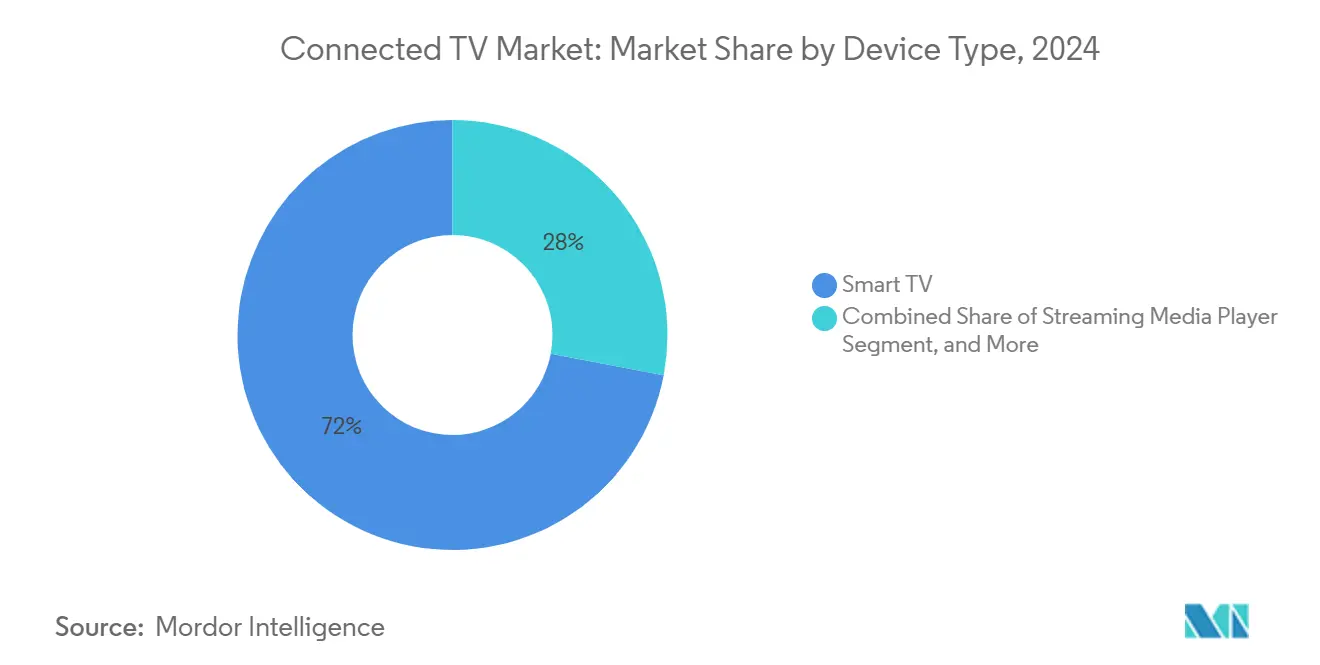
Note: Segment shares of all individual segments available upon report purchase
By Operating System: Roku’s Content-Centric Interface Gains Momentum
Android/Google TV maintained a 38% shipment slice in 2024 through wide OEM uptake and seamless Play Store integration. Roku OS, forecast to accelerate at 14.1% CAGR, wins converts with an accessible UI that pushes free content and simplifies onboarding. This customer-first design bolsters engagement metrics, attracting advertisers to Roku’s proprietary ad stack within the Connected TV market.
Samsung’s Tizen and LG’s webOS leverage vertical integration, optimising performance and offering exclusive ecosystem features such as SmartThings dashboards or ThinQ voice control. Newcomer Titan OS targets European buyers by curating local language services. The platform race fuels continuous innovation—multi-profile sign-ins, spatial audio modes, cross-device hand-off—each shaping the Connected TV industry and intensifying developer workload.
By Resolution: 8K Builds Premium Opportunity
4K UHD commanded 66% of 2024 shipments and remains cost-efficient for mainstream viewers. AI upscaling chips make 4K streams efficient over constrained bandwidth, sustaining its dominance within the Connected TV market. The 8K class, growing 15.5% CAGR, attracts enthusiasts seeking edge-to-edge immersion on screens above 75 inches. Sports leagues pilot native 8K feeds for marquee events, underscoring future potential.
Regulatory headwinds in Europe elevate the importance of energy-saving panel tech. Brands introduce micro-lens arrays, mini-LED backlights and advanced dimming algorithms to meet targets without compromising luminance. These improvements trickle down to 4K models, creating a virtuous cycle of efficiency and picture quality that strengthens the Connected TV market.
By Screen Size: Bigger Displays Capture Premium Spend
Sets rnaging from 46-55 inches captured 42% share in 2024, balancing viewing comfort with apartment real-estate limits. Competitive pricing, thinner bezels and lighter chassis spur upgrades within this core band. Screens 66 inches and above, advancing at 16.3% CAGR, benefit from falling cost-per-inch metrics and consumer desire for cinematic immersion. The Connected TV market size for ultra-large displays will expand as wall-mount innovations and wireless connection boxes simplify installation.
TV makers showcase 98-inch flagships in retail experience zones, bundling sound bars and subwoofers to raise average order value. Interface designers adjust font scaling and menu spacing to suit larger canvases. Streamers encode artwork and trailers in higher resolutions, while calibration firms offer bespoke tuning services-an ecosystem evolving around big screens and reinforcing demand across the Connected TV market.
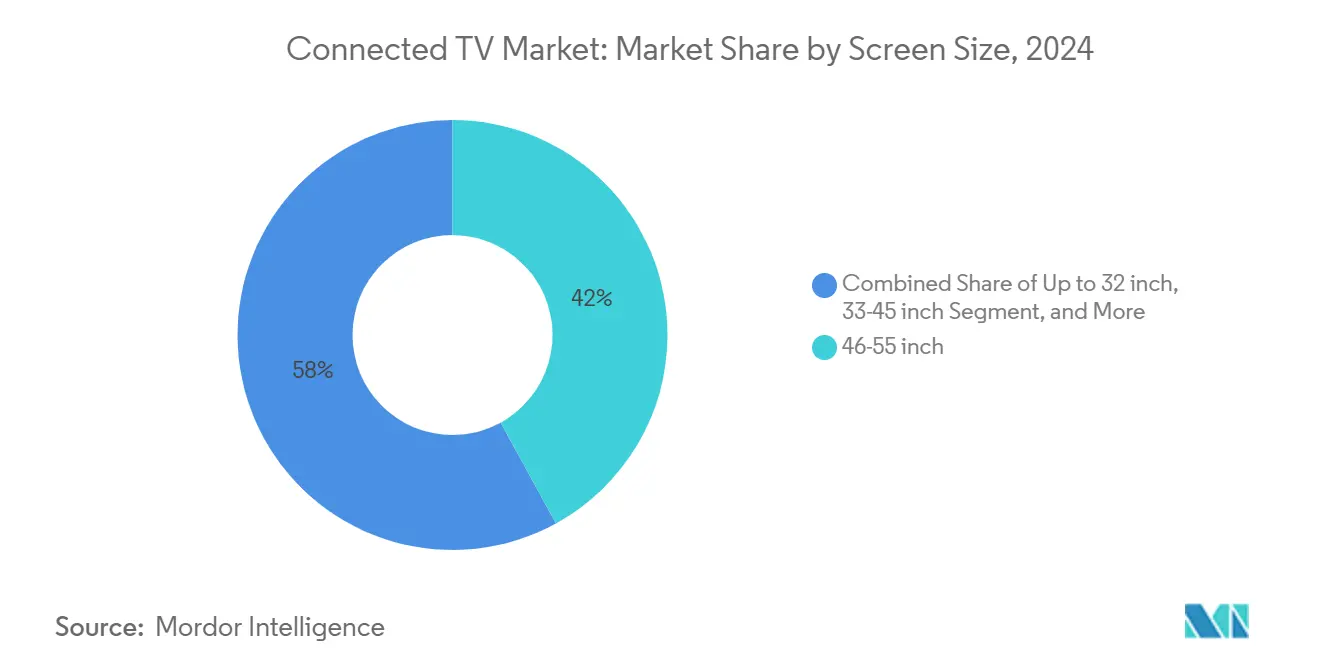
Note: Segment shares of all individual segments available upon report purchase
By Panel Technology: OLED Extends Premium Reach
LED/mini-LED panels held 78% share in 2024, providing high brightness at mass-market price points. Mini-LED backlights with thousands of zones approach OLED-level contrast while exceeding peak luminance, keeping the Connected TV market competitive. OLED, projected at 17.1% CAGR, gains traction as tandem-stack architectures triple brightness and mitigate burn-in. LG and Samsung position their 2025 OLED ranges as gaming flagships with 165 Hz support and near-instant pixel response.
QD-OLED and future micro-LED hybrids promise colour volume and lifespan gains, but cost remains high. Suppliers focus on yield improvements and modular assembly to shorten lead times. As panel tech advances, energy efficiency climbs, helping brands comply with regional regulations while giving consumers eco-conscious upgrade paths in the Connected TV market.
By End-Use: Hospitality Fuels Commercial Upswing
Residential buyers generated 83% of 2024 revenue, yet commercial hospitality is the growth engine at 15.8% CAGR. Hotel chains deploy smart displays that double as in-room service portals, support contactless checkout and deliver targeted ads optimised to guest profiles. These capabilities elevate ADR (average daily rate) and open incremental ad revenue, magnifying Connected TV market opportunity.
Education providers adopt large interactive displays for hybrid classrooms, integrating lecture capture and real-time polls. Corporate lobbies use passive 24/7 signage for brand storytelling and wayfinding. Commercial users demand higher brightness, durable components and remote fleet management dashboards-requirements spawning a parallel hardware line distinct from residential sets and broadening the Connected TV industry footprint.
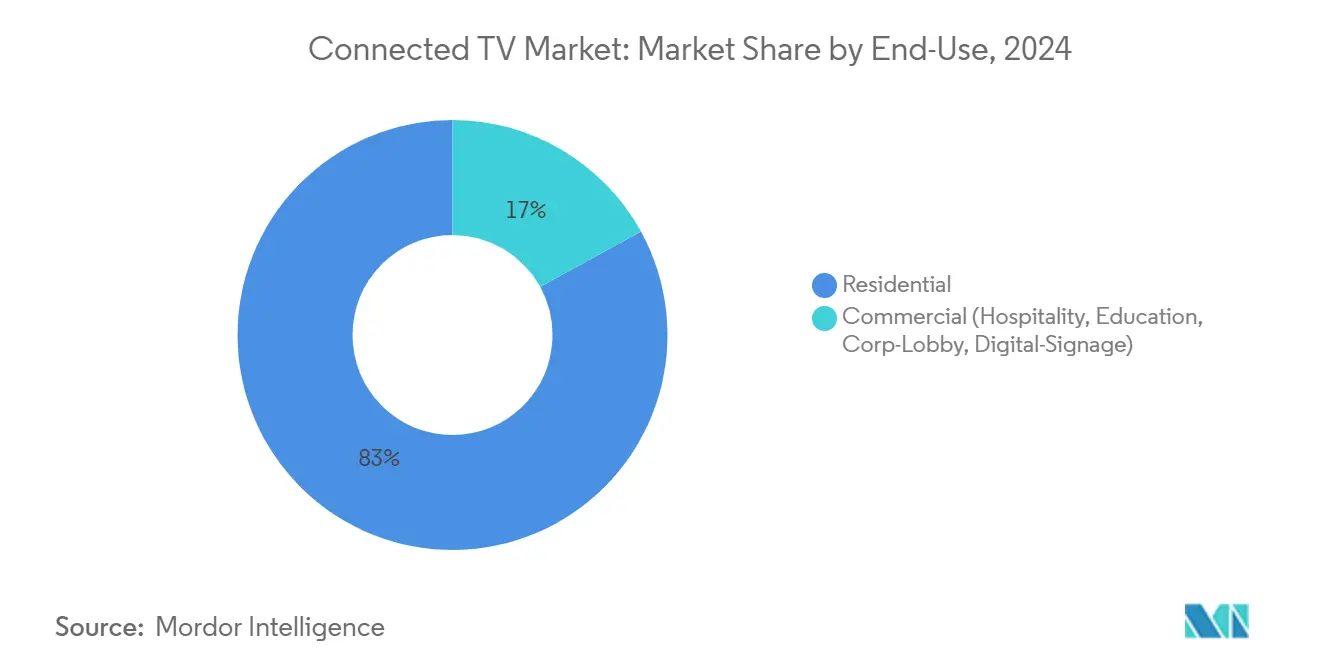
By Distribution Channel: Online Retail Accelerates
Brick-and-mortar outlets retained 62% share in 2024 as shoppers still prefer hands-on picture evaluation. Retailers stage live comparisons of OLED, QLED and mini-LED to showcase differences, driving attachment sales of cables, brackets and extended warranties. The Connected TV market nevertheless pivots online, where channels grow 16.9% CAGR on the back of virtual room visualisers, influencer reviews and next-day shipping.
Brands run direct-to-consumer storefronts, bundling free installation or streaming trials to capture margin otherwise lost to channel mark-ups. Big-box stores counter with click-and-collect, merging web research with rapid pickup. Analytics from e-commerce platforms feed product planning, enabling data-driven SKU rationalisation that boosts profitability throughout the Connected TV market.
Geography Analysis
Asia Pacific led with 37% share in 2024, propelled by a vast population, rising disposable income and mobile-first digital habits. China secured 27.92% of global volume thanks to aggressive pricing by domestic brands and near-ubiquitous broadband. India and Indonesia post double-digit unit growth as operator-financed bundles push first-time adoption.[4]Dentsu Indonesia, " Dentsu Ad Spend Report 2025," dentsu.comProgrammatic ad spend in the region rises 24%, reflecting marketer confidence in addressable reach on Connected TVs. Varying penetration trajectories emerge: mature markets such as Australia, South Korea and Japan surpass 85% household penetration by 2029, while emerging nations target 25-50%. Cultural emphasis on communal viewing further underpins device replacement cycles, sustaining Connected TV market momentum.
North America remains mature yet dynamic. Cord-cutting households overtook pay-TV homes in 2024, catalysing a migration of ad dollars to digital video. Roku, with 37% regional streaming-device share, benefits from early market entry and a rich app ecosystem. Unified measurement standards like CFlight remove barriers for national advertisers, driving Connected TV ad budgets above USD 30 billion in 2024. Power-efficient mini-LED sets address stricter state energy codes, while console-level gaming support differentiates premium models. These trends keep the Connected TV market vibrant despite high base penetration.
The Middle East & Africa, though smaller, is the fastest-growing territory at 17.1% CAGR to 2030. Nationwide fibre builds and affordable 4K panels converge with government visions to diversify economies through media. Saudi Arabia illustrates potential: smartphone penetration sits at 98.2%, average daily video consumption reaches 5.1 hours and local streamer Shahid records 9.5 million unique users. Hybrid distribution—linear TV augmented by OTT—remains strong, generating half of total video revenue. As broadband improves, Connected TV devices become central to home entertainment and smart-home control, accelerating overall Connected TV market expansion.
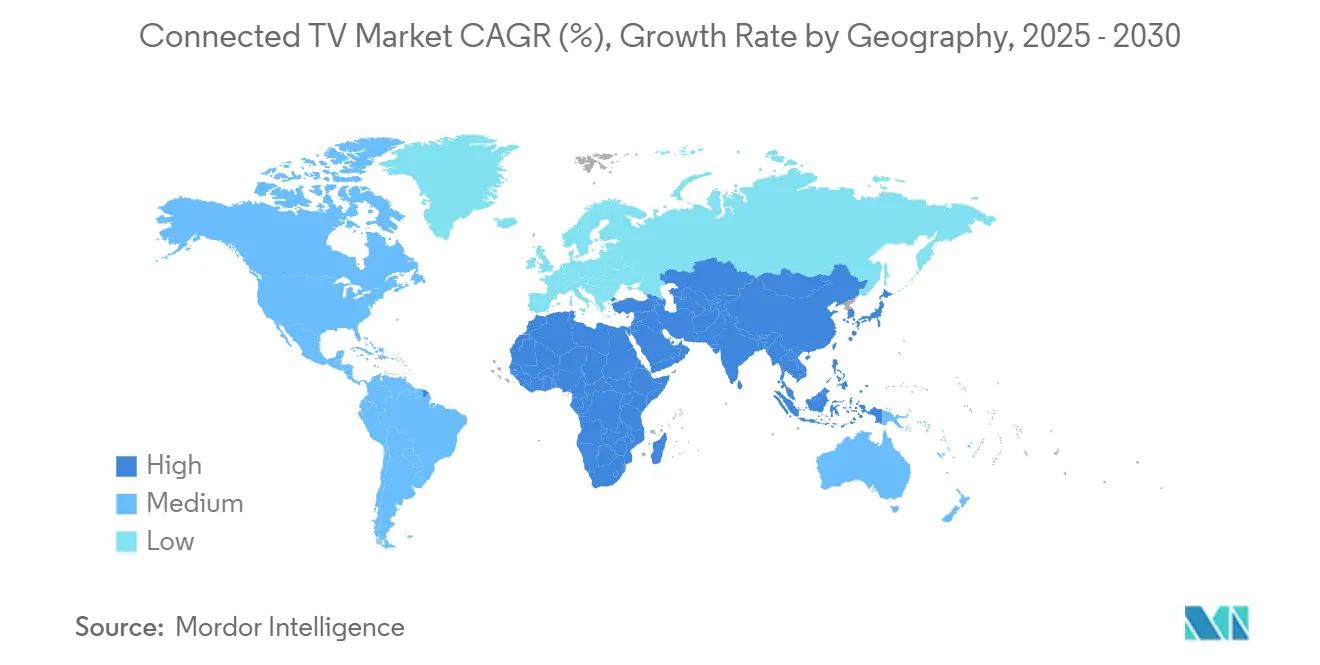
Competitive Landscape
Hardware remains concentrated: the top five brands captured 71.46% of shipments in 2024, giving the Connected TV market a moderately high concentration. Samsung leverages vertical scale, integrating its own semiconductors and panels to deliver flagship mini-LED and QD-OLED models. LG drives OLED innovation with 4-stack tandem emitters boosting brightness three-fold. TCL exploits cost leadership in mini-LED, pushing 98-inch screens into mid-tier price brackets. Hisense and Sony round out the top cohort, each focusing on niche strengths—-value leadership and image processing, respectively.
Operating systems are fragmented. Google licenses Android/Google TV broadly, while Roku differentiates via a content-first interface and proprietary ad stack. Samsung’s Tizen and LG’s webOS sustain loyalty through brand ecosystems and device interoperability. This dual-structure-concentrated hardware, diverse software-creates complex partnering decisions for app developers and advertisers navigating the Connected TV industry.
Strategic alliances intensify. Samsung embeds NVIDIA GeForce NOW to appeal to gamers. Comcast’s Universal Ads platform, built with Roku and AMC Networks, streamlines ad sales across premium inventory. Mediaocean acquires Innovid, merging it with Flashtalking to offer advertisers omnichannel creative personalisation. Hardware players collaborate with panel makers to meet EU energy caps, while telecom operators launch white-label TVs to anchor broadband contracts. Competitive intensity is high, yet white-space exists in AI-driven content discovery and privacy-safe identity solutions—areas poised to shape the next phase of the Connected TV market.
Connected TV Industry Leaders
-
Samsung Corporation
-
LG Electronics
-
Hisense
-
TCL
-
Sony Corporation
- *Disclaimer: Major Players sorted in no particular order
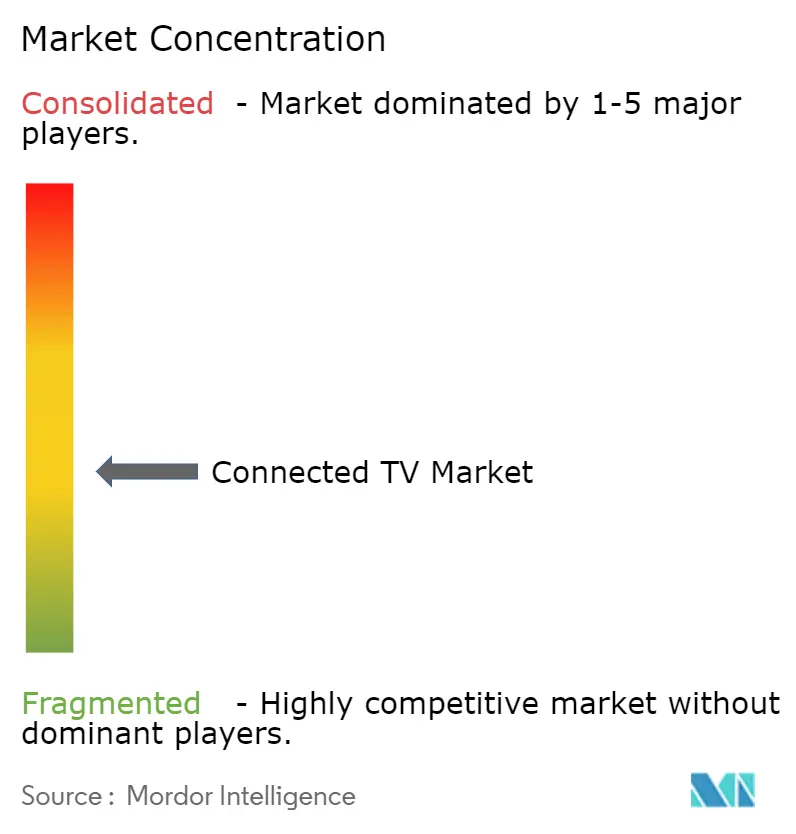
Recent Industry Developments
- May 2025: StackAdapt extended its Samba TV alliance to Australia, giving buyers richer audience insights for regional Connected TV campaigns.
- May 2025: Samba TV partnered with IRIS.TV to enable privacy-compliant contextual targeting across 55 million video assets using Samba AI.
- February 2025: Mediaocean completed its Innovid acquisition, integrating it with Flashtalking to create an omnichannel ad-tech suite spanning linear and Connected TV.
- January 2025: TCL released QM6K mini-LED TVs featuring a Super High Energy backlight chip that lifts brightness 53% on 50- to 98-inch models.
- January 2025: LG introduced a four-stack OLED panel boosting brightness three-fold and enabling 165 Hz refresh on webOS 25 sets up to 83 inches.
Research Methodology Framework and Report Scope
Market Definitions and Key Coverage
According to Mordor Intelligence, the connected-TV market covers every television or plug-in device that ships from an original equipment factory with in-built internet capability, is able to run streaming applications natively, and can be updated over-the-air. This spans smart-TV sets, streaming media players, and current-generation game consoles that double as streaming hubs, valued at ex-factory hardware revenues only.
Scope exclusion: Subscription fees, advertising revenue, replacement remote controls, and legacy flat-panel sets that need external dongles are not part of our sizing.
Segmentation Overview
- By Device
- Smart TV
- 4K and UHD Smart TV
- 8K Smart TV
- HD/FHD Smart TV
- Streaming Media Player
- Gaming Console (Streaming Enabled)
- Smart TV
- By Operating System
- Android TV/Google TV
- Tizen
- webOS
- Roku OS
- Fire OS
- By Screen Size
- Up to 32 inch
- 33-45 inch
- 46-55 inch
- 56-65 inch
- Above 66 inch
- By Resolution
- 4K UHD
- 8K
- FHD and HD
- By Panel Technology
- LED/Mini-LED
- OLED
- QLED
- By Distribution Channel
- Online
- Offline (Speciality, Mass-Retail)
- By End-Use
- Residential
- Commercial (Hospitality, Education, Corp-Lobby, Digital-Signage)
- Geography
- North America
- United States
- Canada
- Mexico
- Europe
- Germany
- United Kingdom
- France
- Italy
- Spain
- Rest of Europe
- Asia-Pacific
- China
- Japan
- South Korea
- India
- South East Asia
- Australia
- Rest of Asia-Pacific
- South America
- Brazil
- Rest of South America
- Middle East and Africa
- Middle East
- United Arab Emirates
- Saudi Arabia
- Rest of Middle East
- Africa
- South Africa
- Rest of Africa
- Middle East
- North America
Detailed Research Methodology and Data Validation
Primary Research
We interviewed chipset vendors, panel suppliers, regional distributors, and large multi-country retailers across North America, Europe, and Asia Pacific. These conversations helped us stress-test assumed sell-in versus sell-through ratios, clarify BOM cost shifts, and obtain forward views on promotional ASP cuts around major sporting events.
Desk Research
Our analysts began with public data from organizations such as the International Telecommunication Union, OECD broadband statistics, China Customs export dockets, and HDMI adopter shipments, which together reveal device flows and connectivity ratios. Industry associations like the Consumer Technology Association and Japan Electronics and Information Technology Industries Association supply quarterly unit shipments and average selling prices, while patent families pulled from Questel hint at future SoC and panel innovations.
To validate pricing and mix, we reviewed 10-K filings of leading TV makers, global retail scanner data, and product catalogs scraped every quarter. Supplementary depth came from paid databases including D&B Hoovers for OEM financials and Dow Jones Factiva for contract news on FAST-channel integrations. The sources listed illustrate our desk work; many additional references were tapped to round out numbers and definitions.
Market-Sizing & Forecasting
We build a top-down model that begins with global flat-panel production, subtracts non-connected units, and then reconstructs regional demand pools through broadband household penetration and smart-TV attachment rates. Supplier roll-ups of sampled ASP × volume plus retail channel checks serve as a selective bottom-up lens to fine-tune totals. Key variables include LCD and OLED panel yields, broadband subscriptions, median TV screen size migration, SoC connectivity attach rates, energy-efficiency regulations affecting 8 K sets, and promotional discount depth. A multivariate regression links these drivers to annual unit uptake before an ARIMA overlay projects five-year trends. Data gaps in country splits are bridged with weighted proxies from import records and operator shipment disclosures.
Data Validation & Update Cycle
Outputs pass three rounds of analyst review, variance checks against independent shipment trackers, and anomaly flags. Reports refresh each year, and interim updates fire when panel tariffs, major component shortages, or regulatory shifts move the baseline. A last-mile review is completed just before client delivery.
Why Mordor's Connected TV Baseline earns trust
Published estimates often differ because firms choose unlike scopes, input series, and refresh cadences.
Key gap drivers include whether advertising and content revenues are blended with hardware value, the choice of retail versus factory pricing, and how non-streaming flat panels are filtered. Our study keeps a strict hardware-only lens and applies annual ASP audits, while some external publishers lift figures from broader entertainment datasets or average multi-year currency conversions.
Benchmark comparison
| Market Size | Anonymized source | Primary gap driver |
|---|---|---|
| USD 10.39 B (2025) | Mordor Intelligence | - |
| USD 290.54 B (2025) | Global Consultancy A | Blends content and ad revenue, uses retail prices without currency normalization |
| USD 93.30 B (2025) | Industry Journal B | Includes all internet-enabled flat panels, limited device-level deducts |
| USD 2.60 B (2024) | Regional Consultancy C | Narrows scope to streaming dongles only, omits smart-TV shipments |
These contrasts show why decision-makers lean on Mordor's disciplined variable selection, single-source gap checks, and annual refresh, giving them a balanced, transparent baseline that can be retraced and replicated by any diligent analyst.
Key Questions Answered in the Report
What is driving revenue growth in the Connected TV market between 2025 and 2030?
Growth stems from rising ad-supported streaming, operator-subsidised smart TV bundles, AI-enhanced viewing quality and unified ad-measurement tools that attract brand budgets.
Which device category is growing fastest within Connected TVs?
Gaming consoles used for streaming show the highest momentum with a projected 15.6% CAGR as cloud services turn them into full entertainment hubs.
How significant is 8K adoption despite European energy limits?
8K units hold a small base yet are forecast at a 15.5% CAGR, supported by falling panel costs and AI upscaling that addresses content shortages outside the EU.
Why are hospitality operators investing in Connected TVs?
Hotels use smart displays for personalised guest services and targeted advertising, helping the commercial segment grow at a 15.8% CAGR through 2030.
Which region will witness the quickest Connected TV market expansion?
The Middle East and Africa region leads with a 17.1% CAGR outlook, buoyed by better internet infrastructure and government support for creative industries.
How fragmented is the operating-system landscape for Connected TVs?
Android/Google TV leads with 38% share, but multiple rival platforms persist, raising app-development costs and complicating content reach across devices.
Page last updated on:
